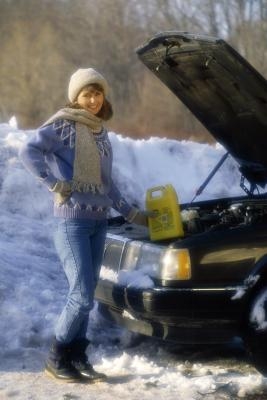
Most vehicles on the road today need a mixture of antifreeze, also called coolant, added to their radiator water to combat a number of problems associated with overheating and freezing. Typical glycol-based antifreeze performs well when it has the correct percentage or concentration in the radiator. Antifreeze not only keeps the radiator water from freezing at very low temperatures, where it could crack the engine block, but it also keeps the water from reaching a dangerous boiling point. Typically, safe amounts of antifreeze range between 50 and 60 percent solution, and it can be measured for it concentration by using an Acustrip three-way antifreeze testing kit.
Place the vehicle in park or neutral and set the emergency brake. Raise the hood. Permit the engine to cool down to a range of between 50 and 130 degrees Fahrenheit. Use an automotive radiator thermometer, just to be sure.
Release the pressure lever on the radiator cap and remove the cap. Open the testing kit and read the instructions. Place the color chart nearby for easy reference.
Remove one test strip from the package. Submerge the test strip in the radiator coolant, wetting all three pads on the stick. Quickly shake any excess from the strip.
Wait 45 seconds and place the strip next to the color chart provided in the kit. You will have 75 seconds or less to make all three pad comparisons. Compare the end pad color (bottom), which is the freeze point pad, to the color on the chart. Determine the closest color match and record the chart box result with a pen and paper.
Compare the color of the second pad, the molybdate indicator on the strip, to the color box on the chart. Record the result with pen and paper. Use the bottom bar on the chart if the molybdate color comes up white.
Compare the third and final nitrate strip pad, the uppermost pad, to the color chart. Record the numerical results with pen and paper.
Pick a color match that looks closest for all three pads. If unsure of the correct hue, pick the next lower shade.
Find where the molybdate level crosses and intersects the nitrate level on the chart. This will indicate the per-gallon SCA units, and you can read the corresponding number that reads the total percentage of antifreeze in the system. For example, the bottom bar shows color boxes from 30 to 60 percent, in increments of 5 percentage units.